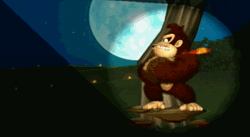 I’ve tried to make these article perennial, I really have, but not even a year has passed since my first FGC post, and already Mark Hamill has made me a liar, Hyrule has produced Linkle, and Super Metroid finally got off its mandibles and went portable. I shudder to think how prehistoric my poor blog will look in another year’s time, when we’re all playing Karnov 2017 and Ecco the Dolphin is the number one game on the Virtual Reality Virtual Console.
I’ve tried to make these article perennial, I really have, but not even a year has passed since my first FGC post, and already Mark Hamill has made me a liar, Hyrule has produced Linkle, and Super Metroid finally got off its mandibles and went portable. I shudder to think how prehistoric my poor blog will look in another year’s time, when we’re all playing Karnov 2017 and Ecco the Dolphin is the number one game on the Virtual Reality Virtual Console.
Though all that is just preamble for my focus of the moment: the Nintendo NX. As I write this, the Nintendo NX is the topic of much debate, as there are alternating theories on whether or not this new system will bankrupt or save Nintendo. Come to think of it, I’m pretty sure that particular debate will rage on until about twenty years after the release (seriously, have we determined how the 3DS fared yet?). But more particular to my interests, as of right now, is that we have no idea what the NX is even going to look like, left alone its features or capabilities. Some claim it will be a mere Super WiiU. Others believe it to be a 3DS/WiiU hybrid system. Still others trust that it will be a penguin taped to an excitable golden retriever (named Brandy). Point is that no one has a clue what to expect, and other than “it will probably have a Mario game”, we’re all in the dark.
Ultimately, this can all be traced back to the Wii. The Wii (appropriately originally nicknamed “The Revolution”) was a complete and total shift in console creation for Nintendo. The “whacky” wiimote utterly changed the landscape of Nintendo games for an entire generation (I want to say Super Smash Bros. Brawl was the only Nintendo game on the system without mandatory shaking/pointing of some sort), and when the WiiU was released with its screen-controller, no one batted an eye at Nintendo’s latest whatsit. 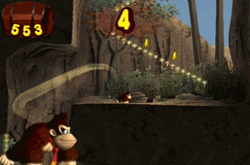 While you can expect the Playstation 5 or Xbox Two to be the same ol’ “like last system, but better!”, everyone is anticipating another interface shakeup from Nintendo. So when the first shots of the NX are leaked, and it’s a perfectly round sphere with seven incongruous buttons, everyone will claim that that’s exactly what they expected.
While you can expect the Playstation 5 or Xbox Two to be the same ol’ “like last system, but better!”, everyone is anticipating another interface shakeup from Nintendo. So when the first shots of the NX are leaked, and it’s a perfectly round sphere with seven incongruous buttons, everyone will claim that that’s exactly what they expected.
But Nintendo has been doing this for a lot longer than we’ve been Wii Bowling. The Nintendo Gamecube was the last (and maybe only) time that the Nintendo system of the day was just another one of three choices. Think about it: the NES had practically no competition, and the N64 required wholly unique programming for its cartridges (in contrast with the joy of CDs on its competitors’ systems). The Super Nintendo was the closest to the “your choice of system” style we have today with Xbone/PS4/PC releases, but, even then, there wasn’t nearly the overlap between Sega Genesis/SNES libraries we see with modern multiplatform releases. The Gamecube, meanwhile, definitely filled the niche of “Nintendo games… and third party, multiplatform releases” that people today claim they want from the next Nintendo system. Gauntlet, Prince of Persia, Spider-Man, Soul Calibur, X-Men (Legends), and even random collections of classic hits from the likes of Midway made their way to the Gamecube just the same as the Playstation 2 or Xbox. Nowadays, we can’t even get a lousy (great!) Mega Man Legacy Collection to grace the WiiU. The Gamecube might have boasted a slightly unusual controller, but beyond some odd button sizes, to the average consumer, the Gamecube was just another video game system choice that happened to have Zelda.
But even at its most vanilla, Nintendo had to try something different.
Going back to the Super Nintendo, Nintendo always had a thing for connectivity between systems. The SNES had the Super Gameboy for playing Gameboy games on the big screen, the N64 had its own add-on for allowing N64 controllers to read Pokémon games, and the Gamecube touted the ability to connect your new GBA as a makeshift controller. Even the Gamecube’s Gameboy Advance Player had a “connection port” so you could potentially play two-player GBA games TV-to-GBA. We really should have seen the WiiU coming.
Similarly, here are the DK Bongos. Like, seriously, here they are:
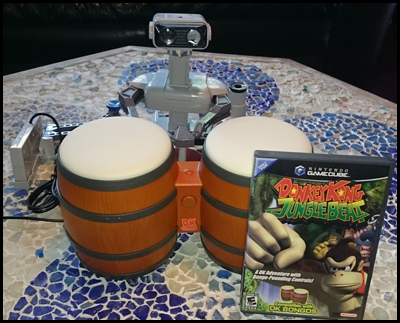
For those of you unfamiliar with ‘em, take a moment to get acquainted with the DK Bongos. There’s a left drum, a right drum, and a straight “button” in the middle. The bongos also have the ability to detect local “noise”, so you can clap and the device will understand that. If you’ve been counting, that makes for five total inputs (left and right drums can be drummed simultaneously). If you’re ignoring the duck option, that’s all the buttons you need to play Super Mario Bros. (left, right, jump, fireball, and start). This is important.
The first and most obvious application of the DK Bongos was its launch rhythm game, Donkey Konga. This was not unprecedented: we were coming off the DDR craze, Guitar Hero was just grabbing a foothold, and even drumming-based games were a thing with Taiko Drum Master. If you were a rhythm game enthusiast, buying some whacky new peripheral was just par for the course. Hell, Samba de Amigo got its own maracas back on the Dreamcast.
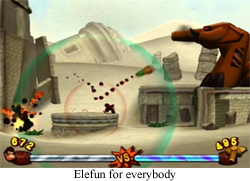 But no one ever made a Sonic game that could be controlled by maracas, or even Halo: Big Plastic Guitar Edition. So when Donkey Kong Jungle Beat hit the shelves… well, there was a little confusion.
But no one ever made a Sonic game that could be controlled by maracas, or even Halo: Big Plastic Guitar Edition. So when Donkey Kong Jungle Beat hit the shelves… well, there was a little confusion.
First of all, DKJB is a 2-D platformer. Nintendo is great at those! And DKJB is a pretty good platformer all on its own, with hidden areas and innovative enemies and beautiful environments. Bosses are fun “find the pattern” affairs, and, assuming you know what you’re doing, they don’t take forever to complete. And, like practically every Donkey Kong game, there’s a score system that is heavily influenced by finding the previously mentioned secret areas (not like DKC secret areas, to be clear, more like “there’s a lot of bananas hiding in that alcove”), or playing the game well, like comboing multiple monster homicides. Ninja monkeys need to die, and you should be rewarded for doing your part.
But the significant difference between this platformer and everything released before it was that this game is entirely controlled by the bongo controller. DK runs right when you beat the right drum, and left for the left drum. Hitting both drums together equals a jump, and clapping will trigger DK doing… something, whether it’s stunning an opponent or grabbing a friendly chimp for a boost. Donkey Kong Jungle Beat is the first bongo-based platformer, and it’s better for it.
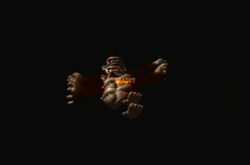 I will admit that when the idea of a bongo-based platformer was first introduced, I was skeptical. But then I played the game, and, well, I don’t mind admitting when I’m wrong. It is an absolute blast to play this game, and it’s primarily because the game is so… physical. Your bongo playing turns DK into a barreling train, and it’s thrilling to build up BPM/speed and then slap both drums together to send the big guerilla flying. In a weird way, I feel that this gameplay is closest to what minecart stages throughout the ages have been trying to achieve, but failed every time. For practically the first time in gaming, there’s a significant feeling of momentum, that you’re not just pressing a direction on a joystick, you’re hammering that monkey to drum forward. It’s exhilarating, and DKJB offers an experience like none other. The “eat everything” finale of every stage is simply astounding.
I will admit that when the idea of a bongo-based platformer was first introduced, I was skeptical. But then I played the game, and, well, I don’t mind admitting when I’m wrong. It is an absolute blast to play this game, and it’s primarily because the game is so… physical. Your bongo playing turns DK into a barreling train, and it’s thrilling to build up BPM/speed and then slap both drums together to send the big guerilla flying. In a weird way, I feel that this gameplay is closest to what minecart stages throughout the ages have been trying to achieve, but failed every time. For practically the first time in gaming, there’s a significant feeling of momentum, that you’re not just pressing a direction on a joystick, you’re hammering that monkey to drum forward. It’s exhilarating, and DKJB offers an experience like none other. The “eat everything” finale of every stage is simply astounding.
And it’s exhausting. And that’s right about when I realized that this game was the Wii prototype.
I’ll be honest, while they were few and far between, I rarely bought the unique Wii version of a game when it was available on other systems. If I bought an Xbox 360 or PS3 game, I could expect a game where I’m thrashing the X/A button a bunch. If I bought that same game for the Wii, I was expected to flail about the room to do the tiniest thing, or break my usual flow and aim the wiimote at the screen, or any other of a number of stupid gimmicks. I know I’m not the first to say this, but so many companies (Nintendo included in a lot of cases) had no idea what to do with the wiimote and its motion sensors, so half the Wii library requires more shaking than a vortexer. Not only does this seem monotonous, but, more often than not, it adds absolutely nothing to the experience, 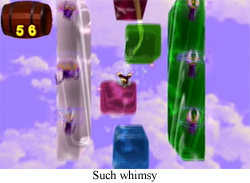 other than a wrist so spent your mother assumes you’re going to go blind.
other than a wrist so spent your mother assumes you’re going to go blind.
But when you play Donkey Kong Jungle Beat, you can see how the Wii could have been a thing of beauty. Don’t get me wrong, I do like the Wii, and enjoy a number of games for it (Super Mario Galaxy 1 & 2 might be the best two Mario games out there, which is high praise), but with so much cruft in the library (and believe me, I’ve played them all), the whole “wiimote” thing seems to average out to a failed experiment. But DKJB really shows how a more physical play experience can be fun, and its closest descendent, appropriately enough, seems to be the roll mechanic of Donkey Kong Country Returns. Yes, like many of you, I would rather have a button to slow that roll in the game (and thank you, 3DS version), but on more “straightaway” levels, I have to say, shaking the wiimote that your mama gave you like there ain’t no tomorrow is a thrilling way to bowl over banana bandits.
So, you know what? I’m ready for whatever Nintendo brings. It might be something simple, it might be something complicated, but I can safely say there’ll be at least one game that showcases the benefits of the system. Even if the Nintendo NX just winds up being a pair of bongos (or, dare I dream, some sort of… double bongos?), I trust that there will be a good experience somewhere in there, because Donkey Kong Jungle Beat already proved that even the weirdest ideas can be marvelous.
FGC #114 Donkey Kong Jungle Beat
- System: Nintendo Gamecube, home of the bongos. There’s also the Wii rerelease that relies on the Wiimote, but it’s just not the same.
- Number of Players: Just one, which is good, as it saves you having to find another pair of bongos.
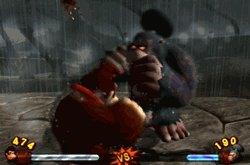 A brief history of Bongos: There were three Donkey Konga rhythm games produced, though only two saw release stateside. With Donkey Kong Jungle Beat, that makes four games that support the DK Bongos peripheral. There was also supposed to be DK Barrel Blast, but that got ported to the Wii before it could gleam the ‘cube.
A brief history of Bongos: There were three Donkey Konga rhythm games produced, though only two saw release stateside. With Donkey Kong Jungle Beat, that makes four games that support the DK Bongos peripheral. There was also supposed to be DK Barrel Blast, but that got ported to the Wii before it could gleam the ‘cube.- And I bet you still have four sets of bongos: Well, yeah. I had to have four-player Donkey Konga times.
- Boss-Out: Oh yeah, while a number of DKJB bosses are typical “dodge and jump” style platforming bosses, there’s a collection of evil Kongs that challenge Donkey in a manner heavily reminiscent of Punch-Out. Dodge blows, then return fire with a left or right hook according to where there’s an opening. Is it any wonder the big ape later battled Little Mac?
- Did you know? Speaking of Super Mario Galaxy, the Donkey Kong Jungle Beat team went on to design that stellar title, and apparently considered reusing the helpful chimps of DK world in Mario’s cosmos… as enemies. That seems like a jerk move, guys.
- Would I play again: Probably, but no guarantees. I really like playing this game, but it’s also kind of exhausting, and requires pulling out a peripheral that, to say the least, doesn’t see much use otherwise. Though, oddly, playing this game makes me want to play Donkey Konga again, so… who knows?
What’s next? Random ROB has chosen… Kangaroo for the Atari 2600. Want to see a boxing kangaroo? Well, you know where to look. Please look forward to it!
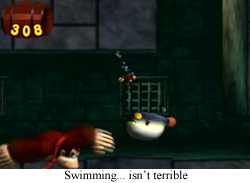
[…] Crossbow Training was packaged with the Wii Zapper, a controller peripheral that, unlike some other odd Nintendo peripherals, should have been a slam dunk. The Wii was the most popular video game system in history, and it […]
[…] get right down to it, has released a lot of random crap over the years. We’ve already discussed the bongos and the Wii Zapper, but that’s just the tip of an iceberg made of pure, frozen piss. Anybody […]
[…] to see Samus as the salesgirl for the latest Nintendo thingy. Samus Aran should have her own pair of bongos, dammit! Wait… that might have come out […]
[…] Would I play again: No. Taiko Drum Master helped me at a time when I needed it (just now), but that damn Taiko peripheral got nothing on my bongos. […]